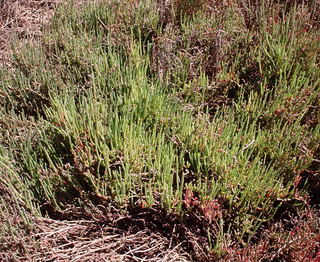
The White Cliffs of Dover, part of the North Downs formation, is the name given to the region of English coastline facing the Strait of Dover and France. The cliff face, which reaches a height of 350 feet (110 m), owes its striking appearance to its composition of chalk accented by streaks of black flint. The cliffs, on both sides of the town of Dover in Kent, stretch for eight miles (13 km). A section of coastline encompassing the cliffs was purchased by the National Trust in 2016.

Crithmum is a genus of flowering plant with the sole species Crithmum maritimum, known as samphire, rock samphire, or sea fennel. Rock samphire is an edible wild plant. It is found on southern and western coasts of Britain and Ireland, on mediterranean and western coasts of Europe including the Canary Islands, North Africa and the Black Sea. "Samphire" is a name also used for several other unrelated species of coastal plant.

Salicornia is a genus of succulent, halophyte flowering plants in the family Amaranthaceae that grow in salt marshes, on beaches, and among mangroves. Salicornia species are native to North America, Europe, South Africa, and South Asia. Common names for the genus include glasswort, pickleweed, picklegrass, and marsh samphire; these common names are also used for some species not in Salicornia. To French speakers in Atlantic Canada, they are known, colloquially, as "titines de souris". The main European species is often eaten, called marsh samphire in Britain, and the main North American species is occasionally sold in grocery stores or appears on restaurant menus, usually as 'sea beans' or samphire greens or sea asparagus.

Port Clarence is a small village now within the borough of Stockton-on-Tees and ceremonial county of County Durham, England. It is situated on the north bank of the River Tees, and hosts the northern end of the Middlesbrough Transporter Bridge.

Fenit is a small village in County Kerry, Ireland, located on north side of Tralee Bay about 10 km (6 mi) west of Tralee town, just south of the Shannon Estuary. The bay is enclosed from the Atlantic by the Maharee spit which extends northwards from the Dingle peninsula. Fenit harbour is a mixed function sea port, where fishing, freight import and export, and a 136 berth marina are the main forms of business. The population was 527 in the 2011 CSO census compared to 427 in 2006.

The golden samphire is a perennial coastal species, which may be found growing on salt marsh or sea cliffs across western and southern Europe and the Mediterranean.

Tralee Bay is located in on the west coast of County Kerry, Ireland. It is situated between Kerry Head on the north side and the Maharees on the west and extends eastwards as far as the bridge at Blennerville. Several small rivers feed into the bay through the town of Tralee. Villages around the bay include; Ballyheigue, Fenit, Kilfinora, Spa, Blennerville, Camp and Castlegregory.

TUC crackers are salted octagonal golden-yellow snacks comparable in taste to Ritz crackers. The TUC brand originated in Belgium. Presently, Mondelēz International markets TUC crackers in mainland Europe, while Valeo Foods' Jacob Fruitfield Food Group produces TUC crackers for markets in Europe, Asia, North America, and North Africa.

Hougham Without is a civil parish between Dover and Folkestone in southeast England. The main settlements are the villages of Church Hougham and West Hougham, collectively known simply as "Hougham". Great Hougham Court Farm is located to the south of the two villages, near the Dover transmitting station. The Channel Tunnel runs underground just south of West Hougham and directly under both Church Hougham and the Farm.

Samphire Hoe Country Park is a country park situated 2 miles (3 km) west of Dover in Kent in southeast England. The park was created by using 4.9 million cubic metres of chalk marl from the Channel Tunnel excavations and is found at the bottom of a section of the White Cliffs of Dover. The site is owned by Eurotunnel Ltd., and managed by the White Cliffs Countryside Project.

Tecticornia is a genus of succulent, salt tolerant plants largely endemic to Australia. Taxa in the genus are commonly referred to as samphires. In 2007, the genus Halosarcia, along with three other Australian genera was incorporated into the genus.

The Vasse-Wonnerup Estuary is an estuary in the South West region of Western Australia close to the town of Busselton. The estuary is listed with DIWA. It was also recognised as a wetland of international importance under the Ramsar Convention on 7 June 1990 when an area of 1,115 ha was designated Ramsar Site 484 as an important dry-season habitat for waterbirds. It is also the main part of the 2,038 ha Busselton Wetlands Important Bird Area.

Salicornia europaea , known as common glasswort or just glasswort, is a halophytic annual dicot which grows in various zones of intertidal salt marshes. The ashes of glasswort and saltwort plants and of kelp were long used as a source of soda ash for glassmaking and soapmaking. The introduction of the LeBlanc process for the industrial production of soda ash superseded the use of plant sources in the first half of the 19th century.

Glasswort salad or samphire salad is a salad in Turkish cuisine. Glasswort salad is made with glasswort, lemon juice, olive oil and garlic.

Franklin Harbor Conservation Park is a protected area in the Australian state of South Australia located on the east coast of Eyre Peninsula in the gazetted locality of Cowell about 5 kilometres south of the town centre in Cowell.

Butcher Gap Conservation Park is a protected area located in the Limestone Coast of South Australia overlooking Lacepede Bay about 6 kilometres south of the town of Kingston SE. The conservation park was proclaimed under the National Parks and Wildlife Act 1972 in 1990.
















